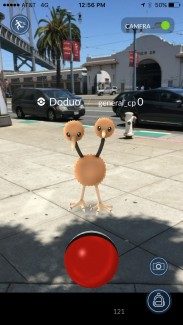The announcement video for Pokémon Go, an “augmented reality” game for smartphones, opens by asking us to “imagine Pokémon in the real world.” And imagination is exactly what you’ll need to consider the game as landing anywhere within the realm of augmented reality.
Pokémon Go might be a decent game (I can’t say for sure; a week in the closed beta ‘Field Test’ didn’t give me much feel for it), but if it wants to be judged as an “augmented reality” game then it’s either a terrible augmented reality game, or it’s playing fast and loose with the definition.
Now I get it, definitions are mutable and often have blurry boundaries. But we need to at least be able to see the shape of a definition in order for it to be useful to discourse. If we let that go we risk ending up in a world where a word like “literally” can literally mean “figuratively,” which can make a sentence like this figuratively illegible.
Let’s start with the announcement video I mentioned. It’s actually a great concept video for AR. Titled Discover Pokémon in the Real World with Pokémon GO!, and viewed a whopping 25 million times, it implies in no uncertain terms that users would see Pokémon convincingly hiding in real world environments, with players physically throwing Poké Balls in order to capture them, and that crowds would gather to see Mewtwo flying around Times Square in an epic battle (you know, the kind of stuff that Magic Leap is actually doing). Meanwhile the actual gameplay appears pathetic by comparison and is shown for mere seconds following the three minute CGI piece that came before it.

So in what ways is Pokémon Go ‘augmented reality’? Nearest I can tell it has something to do with the camera view that, upon discovering a Pokémon, shows the creature haphazardly superimposed on whatever your camera happens to be looking at.
The thing is, in order to ‘augment’ reality, the system doing the augmentation needs to know something about your reality; like how Snapchat knows the shape of your face so that it can augment it in interesting ways. But Pokémon Go knows nothing more about your reality than almost any other app on your phone.
Because of this, you’ll frequently find Pokémon floating superimposed into walls or other objects in a way that doesn’t make sense, with their scale totally misrepresented against a backdrop that doesn’t suit their size at all. When you walk toward the Pokémon they’ll simply slide along the ground at a fixed distance from you, passing through whatever real world obstacles might be in their way. This isn’t augmenting reality, it’s merely conflicting with it.
Aside from the superimposed camera view, which you can (and likely will) opt to turn off with a small button at the top right of the app, the only other argument to be made for Pokémon Go as an AR app is that in order to find Pokémon and other game objectives (like gyms), you have to physically move around the world (a quick stroll up the street might reveal a few).
 But unlike the CGI video, you won’t find any Pokémon hiding behind trees or battling atop bridges. You’ll simply be looking at the map on your smartphone (which takes the form of a stylized version of the sorts of roadmaps you’d find on Google Maps) and occasionally see a Pokémon pop up on the screen. Then, whether you’re 10 feet for 50 feet from them, just tap on your smartphone and you’ll be engaged into the superimposed camera view to capture the creature.
But unlike the CGI video, you won’t find any Pokémon hiding behind trees or battling atop bridges. You’ll simply be looking at the map on your smartphone (which takes the form of a stylized version of the sorts of roadmaps you’d find on Google Maps) and occasionally see a Pokémon pop up on the screen. Then, whether you’re 10 feet for 50 feet from them, just tap on your smartphone and you’ll be engaged into the superimposed camera view to capture the creature.
Once again, not AR. Unless, that is, that we also want to consider Google Maps, GrubHub—and any other app that shows my location and things around me on a map—augmented reality. There’s no doubt that tracking is a necessity for great AR. But GPS-level tracking doesn’t have anywhere close to the fidelity you’d need to, say, actually feel like you’re walking up to a Pokémon in a way that allows it to be convincingly anchored to your view of the real world. And without that—if the augmented information isn’t convincingly integrated into our reality—it’s, at best, a HUD, and at worst, just like any old app.
Pokémon Go could be an amazing AR app, if only they delivered anything remotely like what was shown in their audacious CGI video. Until then, let’s not muddle the definition of augmented reality lest we want it to become a meaningless buzzword. For those interested in the game (even if it isn’t AR proper), today marks the end of its closed beta, and it’s expected to launch later this month on Android and iOS and will be free-to-play when it does.







